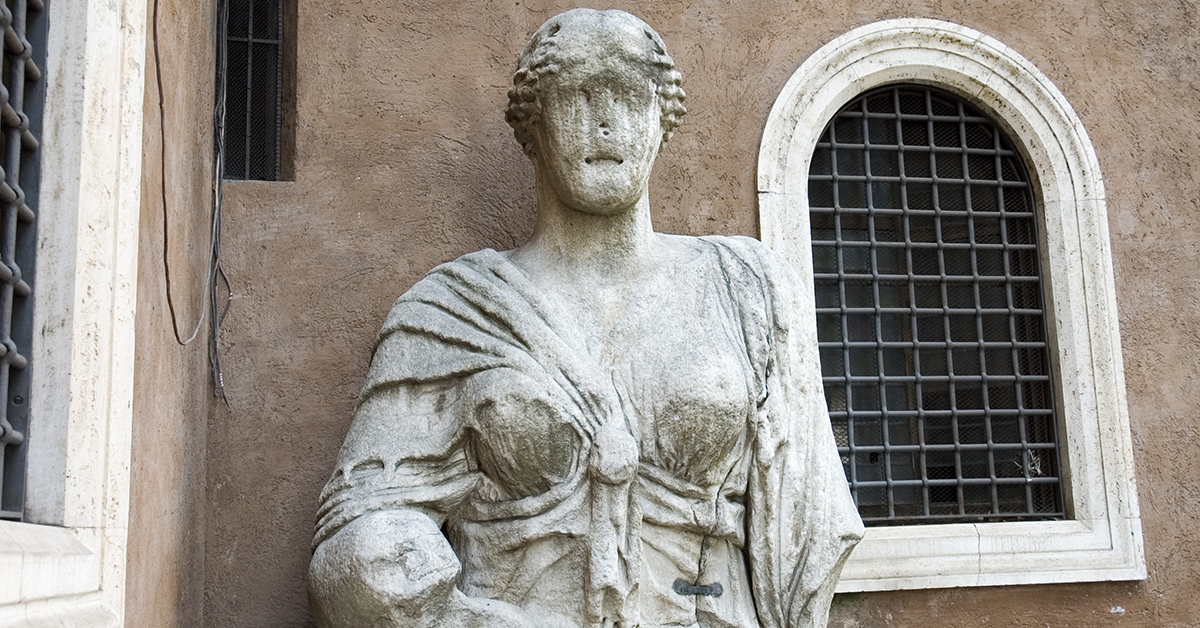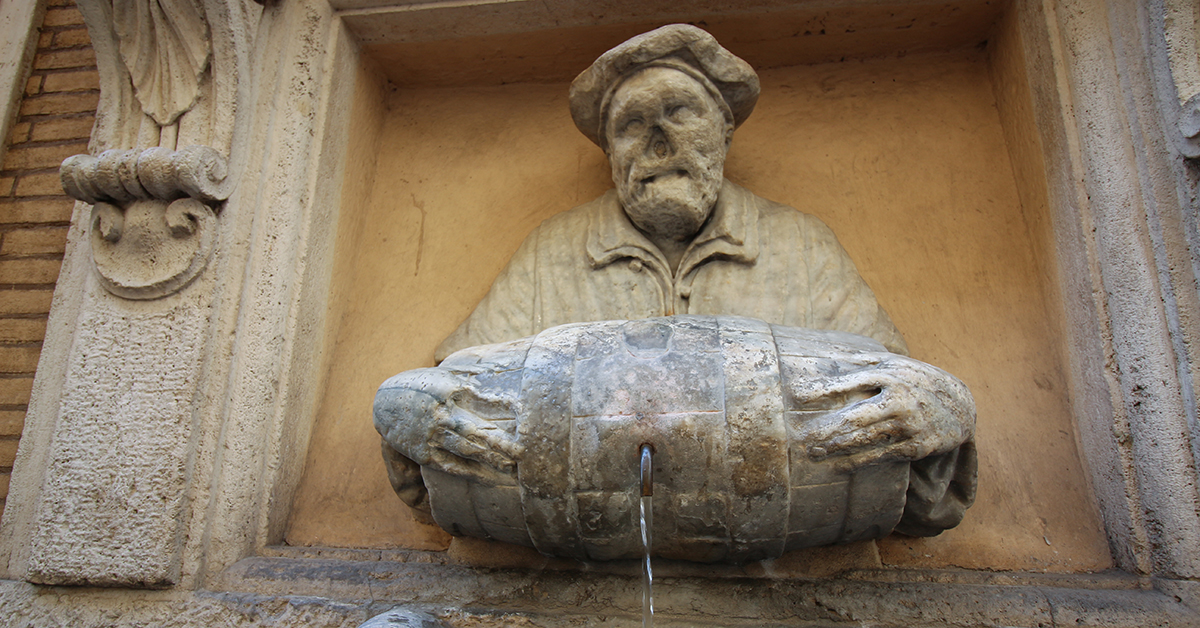
For believers in the supernatural, the city of Rome is haunted by the ghosts of its long and often sordid history. From the phantoms of ancient gladiatorial combats said to wander the tunnels beneath the Colosseum to the tragic spectre of Beatrice Cenci, who is said to be visible crossing the Ponte Sant’Angelo carrying her severed head, phantoms from the many ages of Rome are said to populate the metropolis and its outskirts.
Also haunting in their own peculiar way are the famous statue parlanti or talking statues of Rome. Known as the Congregation of Wits, this group of six statues began “speaking” in the 16th century. It isn’t clear how it all started, but the people of Rome used these statues to criticize their leaders via sarcastic written commentary posted near the statutes. As the common folk were mostly illiterate, it was likely members of noble Roman families, academics and intellectuals who were behind the notes.
How it all began: Pasquino
The statue that inaugurated this peculiar form of public discourse was long ago nicknamed Pasquino. A fragment of a sculpture produced in the 3rd century BCE, Pasquino is thought to have represented Menelaus from Homer’s Iliad. Some historians suggest that the original, living Pasquino was a tradesman whose business was near the statue’s location in the Piazza di Pasquino. Popular belief says the notes started because Pasquino resembled a despised teacher whose students began mocking him by affixing messages to his neck.
Through the years, the small notes written in Latin were replaced with larger signs, flyers, and posters. Their content became more aggressive and satirical and their targets were more powerful than local teachers: they were popes and, later, other authority figures. These messages came to be known as pasquinate, named after the first talking statue.
A number of popes through the centuries tried to staunch the flow of public criticism by moving the statues or placing round-the-clock guards on them, but their efforts were always futile.
In addition to Pasquino, five other sculptures around the city joined the public dialogue.
Il Babuino
Il Babuino, a satyr (named because he resembled a baboon) is located on via del Babuino. This ancient sculpture was moved from a previous location to decorate a fountain newly constructed in 1581.
Il Facchino
Third in the group was Il Facchino (the porter). Located on via Lata near the Piazza Venezia, it depicts a cap-wearing fellow hauling a barrel or acquarolo. Basically a street vendor, a facchino would haul water in a barrel at night from the Tiber river or Trevi Fountain to the streets to sell during the several-hundred-year period when the city’s ancient aqueducts had fallen into disrepair. The face of the statue is disfigured after sustaining countless assaults through the years from paving stones torn up from the ground and flung his way.

Marforio
Fourth in the lineup and second only to Pasquino in importance is Marforio (Marphurius in Latin), the river god. In the most active period of the talking statues, Pasquino and Marforio spoke to one another. One would inquire of the other about a political or social issue and the one responding would do so with biting satire.
It isn’t clear if Marforio is the god Triton or Neptune. It could also be a personification of the Tiber River. The statue rests above a colossal pool of water in the historical center of Rome near the Palazzo Nuovo. Its name may have originated because it was once located in the Forum of Mars in front of the ancient prison of Mamertine. Alternatively, it may have been named after the Marforio family who owned land near the prison.
Madama Lucrezia
Formidable in size and appearance, the fifth talking statue is an ancient colossal marble statue named Madama Lucrezia. The imposing figure with a distorted, flattened face is located near the Basilica San Marco in the Piazza di San Marco on the corner of Altare della Patria. It isn’t clear who the original sculpture was intended to represent. Some say she’s the Egyptian goddess Isis or one of her priestesses because the bow on her garment is suggestive of Egyptian costume.
As to who the namesake of the bust “Lucrezia” refers to, the answer isn’t necessarily clear. Lucrezia d’Alagna, the mistress of King Alfonso V of Naples was said to have been the owner of this bust. However others refer to “Lucrezia” of the Bolgia family, the infamous daughter of Vannozza dei Cattanei and Pope Alexander VI. A pawn in several arranged marriages between powerful families, Lucrezia has been cast historically as a Renaissance-era femme fatale. At the end of the 18th century, the sculpture evidently fell from its plinth and broke into eight different pieces.
Abbot Luigi
Last but not least, the so-called Abbot Luigi, another ancient sculpture given a fresh Renaissance persona, is just a block south of the Corso Emanuele Vittorio II near the Church of Sant’Andrea della Valle. He wears the traditional long robe of a senator or magistrate of Ancient Rome and stands in the orator’s pose. The head we see today is a replacement, as the earlier head was removed in 1888. Then in 1970, that head was stolen and yet another took its place.
An anonymous forum for risky public conversations
Far from jocular public debates, the written conversations that took place in close proximity to this collection of statues were risky for the participants. In 1520, Pope Adrian VI proposed tossing Pasquino into the river. In 1636 a cheeky aristocrat lost his anonymity and his head after posting a note. His message ridiculing Urban VIII did not amuse the pontiff, needless to say. In the 1720s, an edict issued by Benedict XIII ensured a death sentence for any person audacious enough to leave a message at one of the statues. Never easily deterred, Roman commentators persisted, leaving verses affixed near the statues in the dead of night.
The custom fell out of favor until the 20th century, when Romans revived it to criticize Hitler on the occasion of his 1938 visit to Rome. Messages continue to appear, including in 2011 when brief but biting comments such as “Italy is not a brothel!” were posted in response to former Prime Minister Silvio Berlusconi’s multiple scandals.
Occasionally, attempts are made to clean up and preserve the statues. When the statue of Pasquino was covered with graffiti, a written response appeared: Potete pure fasciarlo ma Pasquino non stara mai zitto!, which means: “You can wrap Pasquino well but he will never shut up!”


